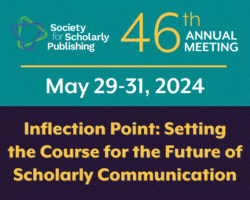May 30, 2013 – By Tracey DePellegrin, SSP Communications Committee
For science researchers, the impact of the 2013 federal sequestration is starting to show signs that tough times are about to become even tougher.
Jennifer Zeitzer, director of legislative relations, Federation of American Society for Experimental Biology, notes that the cuts due to sequestration that was reported by the National Institutes of Health (NIH) on May 8 as a $1.71 billion (or 5.5%) reduction from 2012 will exacerbate the current challenges facing the research community.
And sequestration’s ramifications stretch beyond the research community, to scholarly publishers. With fewer grants being funded and fewer research projects being conducted, the output of that research (in the aggregate) – the total number of submitted manuscripts and published research articles – will almost certainly decline. The potential consequences for publishers, then, range from intellectual to financial and other losses, as an already competitive marketplace realizes sequestration’s broad and deep ripple effects.
“Rising costs of research, the increasing complexity of the scientific enterprise, and a loss of purchasing power at the (NIH) due to flat budgets have made it increasingly competitive for individual investigators to obtain funding,” said Zeitzer.
In fact, because about 85% of NIH’s budget supports extramural grants, widespread agreement exists that research grants in American hospitals and universities will bear the brunt of the cuts resulting from sequestration. According to recently released statistics from the NIH detailing its grants, the numbers are grim. Science reports that NIH expects to fund 8,283 new and competing research grants this year, a drop of 703. When one considers the awards coming to a close, the total number of research grants in play falls by 1,357 to 34,902.
“I worry desperately that this means we will lose a generation of young scientists,” said Francis Collins, MD, PhD, director of the National Institutes of Health. If they are unable to secure funding or a research position, these scientists may be forced into industry, or even to leave the United States
On May 7, Collins turned to social media to see if others in the field were as concerned as he was. He twitted, “I want to hear…tell me how the #sequester is affecting your biomedical research right now. Use #NIHSequesterImpact.”
Nearly 1,000 responses poured in within a few days. One reply stated, “The prospective cohort biosamples that will be lost are irreplaceable. They were accumulated for over 30 years.”
Another reply said, “…makes small independent institutes scramble to survive. What are the nation’s priorities?”
The NIH is not the only scientific agency forced to trim its budget due to the sequestration. Nearly every state in the nation receives federal funds from other agencies such as the National Science Foundation (NSF), the Department of Energy Office of Science (DOESC), and the Department of Agriculture (USDA).
The NSF, which funds 20% of federally supported research at U.S. colleges and universities, reported in a press release that the major impact of sequestration will be a reduction in the number of new research grants and cooperative agreements awarded in 2013. The foundation, however, expects no impact on its existing grants.
“I think the fallout is still not clear,” said Dr. Michael Snyder, director at Stanford University’s Center for Genomics and Personalized Medicine. “Several of our faculty are wondering if their grants will be funded, and others are getting their grants trimmed. I think it is having a significant effect on student and postdoc morale because it makes them question whether an academic career is viable within this funding climate.”
Because biomedical research projects are complex and often span years, the effects on scientific research and discoveries will be felt in both the short and long term. These cuts may initially happen with lab personnel layoffs or suspended projects, but several bracing questions loom: What discoveries will not be made or what treatments will not be developed as a result of the cuts? How will the sequestration affect the United States’ position in the worldwide biomedical research community? How can such inevitable broad and deep losses and opportunity costs – scholarly, financial, medical and health-related – even be measured?
In concrete terms, FASEB predicts the cuts will affect research in vaccine development, cancer, diabetes, new and existing infectious disease, neurological diseases, and dementia, to name a few.
Because sequestration came into effect recently (March 1, 2013), the impact on scientific publishers and stakeholders will not be felt immediately, considering that most federally-funded research published in scholarly journals is in play for several years before a manuscript is even submitted. At the same time, each type of scientific publisher and those involved in disseminating the research articles—from scholarly societies to commercial publishers, to a myriad of vendors, institutional libraries, tech development firms, and others—has a stake in the outcome of the budget cuts. Increased competition for fewer papers will have serious consequences for continued investment and progress in, and perhaps even the sustainability of all involved in scientific publishing.
Tracey DePellegrin is Executive Editor, Genetics Society of America Journals GENETICS and G3: Genes|Genomes|Genetics.



Join the Conversation
You must be logged in to post a comment.